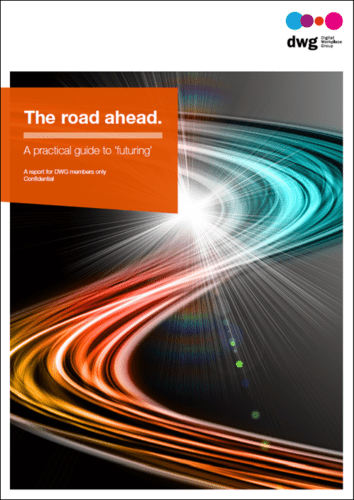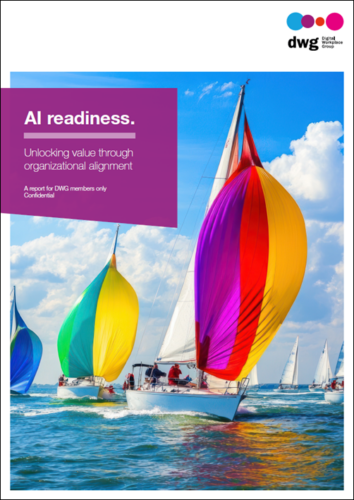20/20 foresight: Envisioning the future workplace
Anticipating how technological and societal trends will shape the future of work is one of the thornier challenges of corporate leadership.
Reluctant to miss out on game-changing progress, decision-makers are at the same time wary of placing big bets on emerging – and potentially overhyped – innovation.1 There is a case for treading carefully. As a recent Economist article noted, significant workplace advances, from the tractor to the personal computer, have taken time to achieve global impact (although the latency period for newer technologies is undoubtedly shortening).2 In an age of burgeoning automation and artificial intelligence (AI), the need for informed thinking on the pace and nature of organizational change seems particularly clear. The research firm Gartner predicts, for example, that by 2028 more than 50% of enterprises that rushed into building large AI models will have abandoned their efforts due to “costs, complexity and technical debt in their deployments”.3
DWG’s latest member-only research report, The road ahead: A practical guide to futuring (non-members can download a free excerpt), looks at how organizations can explore, in comparative safety, the distant horizons of technology and workplace advancement.
As well as reviewing some of the models and methodologies that underpin such work, the report addresses specific issues such as:
- how futuring work should be structured
- the time horizon digital teams should adopt
- the competencies needed to deliver meaningful insights.
Case vignettes on topics ranging from AI implementation to broader workplace evolution give a flavour of how futuring projects can impact strategic and tactical thinking. The report also includes a Q&A with George Muir of Udal Cuain AB, architect of an ambitious future-of-work initiative at IKEA and now an independent advisor to corporate clients on HR and digital innovation.
What is futuring?
Futuring is defined as “the practice of envisioning and planning for potential futures, often through a systematic process that includes analysis, exploration and forecasting”.
The idea is that, by evaluating digital, economic and sociocultural trends, organizations can do better at balancing short-term performance with the longer-term planning needed to build a healthy, sustainable, competitive future for themselves and their people.
The futurist’s mission is explicitly not to make concrete predictions, but rather to set out a range of scenarios as a catalyst for strategic and creative thinking. Freed from a purely operational mindset, practitioners aim instead to stretch perceptions of the way ahead by presenting possible futures that are not simply a continuation of the present.
‘Futuring’ versus ‘visioning’
The report cites a useful distinction drawn by business author and futurist Stephen Millett between two types of foresight activity: ‘futuring’, which involves identifying distant opportunities and threats; and ‘visioning’, which prepares teams to adapt and thrive in the world to come.
Futuring, in Millett’s schema, involves moving from the ‘macroscopic’ (concerned with the external environment) to the ‘microscopic’ (concerned with corporate goals, assets and culture). The aim is to understand the market and operating conditions teams may face as a prelude to internal change.
Visioning tackles the same challenge but from the opposite direction. Beginning at the ‘micro’ level, it evaluates current operations and resources before asking how organizations can set a course to long-term performance. The process tends to be more motivational and emotive than futuring, containing “a high dose of desire”, Millett observes. It also requires greater input from internal stakeholders to build consensus on the vision itself and the goals, strategies and investments that flow from it.
Futuring techniques covered
The report’s main sections cover a selection of formal models and techniques teams can employ to prepare themselves for an uncertain future. They include:
- The ‘Delphi’ technique: a systematic process for mining top-tier expertise beyond the organization to forge consensus on the way ahead.
- The ‘7 Questions’ method: using highly structured, one-on-one interviews to stimulate forward thinking and pinpoint issues to be addressed in strategy formation.
- The ‘Three Horizons’ model: planning for innovation across several timeframes to ensure that existing capabilities are replenished at exactly the right time.
- ‘Imagineering’: drawing inspiration from the Walt Disney Company’s research and development arm to foster creative solutions to workplace planning.
- ‘Backcasting’: working backwards from an imagined future to contemplate how wished-for outcomes might be achieved.
- DWG’s ‘Nature of Work’: embedding a new vision of the workplace as a dynamic, ‘living’ system that thrives through its adaptive structures and practices.
- Horizon scanning and scenario planning: picking up on weak signals of change to imagine a range of possible futures (as exemplified by the UK government’s comprehensive foresight work on public wireless service provision, which is featured in the report).
References
1 From potential to profit with GenAI BCG AI Radar, January 2024
2 What happened to the artificial intelligence revolution? The Economist, July 2024
3 Take this view to assess ROI for Generative AI Gartner, August 2023
Categorised in: Future of work, Future of work
Related articles

